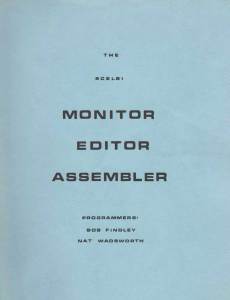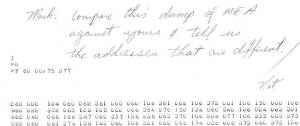Like so many other things in the SCELBI world, it’s best to let the creators describe it for you.
THE SCELBI MONITOR/EDITOR/ASSEMBLER PROGRAM, ABBREVIATED IN THIS MANUAL AS “MEA” IS A POWERFUL SOFTWARE PACKAGE THAT COMBINES THE FUNCTIONS OF A MONITOR, EDITOR, AND ASSEMBLER IN A RESIDENT, CONVERSATIONAL TYPE ARRANGEMENT. THE PACKAGE IS STANDARDLY SUPPLIED ON A PROGRAMMABLE READ ONLY MEMORY ELEMENTS THAT RESIDE ON PAGES 60 THROUGH 77 (OCATL) FOR USE IN A SELBI-8B MINICOMPUTER. I/O ROUTINES FOR THE PACKAGE ARE SUPPLIED ON TWO SEPARATE “PROMS.” THE STANDARD SCELBI AUDIO TAPE DRIVING PROGRAM RESIDES ON PAGE 77. I/O ROUTINES FOR THE SPECIFIC I/O HARDWARE TO BE USED WITH THE SYSTEM IS PROVIDED ON A PROM ON PAGE 76. TWO STANDARD I/O VERSIONS ARE AVAILABLE. ONE FOR SYSTEMS EQUIPPED WITH THE SCELBI OSCILLOSCOPE ALPHANUMERIC DISPLAY INTERFACE AND SCELBI ASCII KEYBOARD INTERFACE, THE OTHER FOR SYSTEMS USING A MODEL 33 TELETYPE INTERFACED WITH THE SCELBI BIT-SERIAL TTY INTERFACE. OTHER TYPES OF I/O DEVICES CAN BE ACCOMMODATED BY SPECIAL ARRANGEMENT AND SUBSTITUTION OF APPROPRIATE I/O ROUTINES PROGRAMMED ONTO A PROM ON PAGE 76.
Here is the cover of the manual, which can be found at scelbi.com.
This development environment, which was available in 1975, was quite an achievement for the time. The environment was “robust” enough that Mark Arnold used it to develop SCELBAL. Few other “personal” computer systems available in 1975 had such capabilities built in. For instance, Microsoft BASIC for the 8080/Altair was developed in emulation on a PDP-10.
Also at scelbi.com is a intel hex file of the contents of the PROM card. This version of the contents was painstakingly reconstructed by Mark Arnold from an object listing that was sent from Nat Wadsworth to Mark when Mark started experiencing problems with the EPROMs on his system back in the old days. It’s very fortunate that Mark saved this listing.
The listing was just a raw dump and where it was folded the data was illegible. Mark and Cameron Cooper managed to get MEA up and running in emulation and used the emulator to help reconstruct the missing data, so they believe the hex file at scelbi.com is correct.
The version they have, is set up for the TTY interface. So far, we haven’t been able to find a surviving version of the oscilloscope drivers that would replace the TTY drivers on page 76. I think it’s rather unlikely at this point that we will be able to find the oscilloscope version, so that version will most likely have to be rewritten from scratch.
We have the TTY version of the MEA program and I have already done the TTY interface card, so we are getting close to having reconstructed a complete SCELBI 8B running MEA. After completing the PROM card, my next efforts will be to do the cassette interface, which will allow running the MEA system as it was intended on real hardware.
In order to get MEA working in my OS/X emulator, I’ll need to enhance the terminal support to act more like a real TTY as CR and LF are separate functions and I’ll also need to figure out how to support backspace. I also intend to add cassette interface emulation support to my emulator to allow complete support of MEA in emulation.



